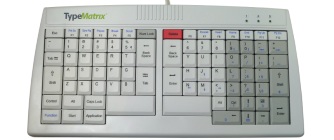Passwords
One of the first things you’ll learn when you try to adopt a new keyboard layout is that you have an extremely hard time logging in anywhere. That’s because your muscle memory no longer works for passwords and since that is what you usually rely on, you now have to spell everything out mentally. Even then, it still usually ends up wrong because you can’t see any mistakes you’re making. This can be very frustrating until you are proficient with the new layout.
This is a good reason to go with the recommended PKL until you are proficient at Minimak. PKL allows you to turn the Minimak layout on and off with a hotkey. Just hit both Alt keys together and it will suspend Minimak, putting you back in QWERTY. Handle your login, then hit both Alts again to toggle back to Minimak. You’ll want to do this whenever you deal with passwords.
Creating Passwords
You especially don’t want to use Minimak to create new passwords until you are 100% accurate. That’s because learning a new layout (temporarily) makes you mistype letters in a consistent and reproducible fashion. If you do try to make passwords, you will typically end up with a password that’s good enough to get most systems to accept it, since you can type it the same way twice, but isn’t the password you thought it was because you couldn’t see your (consistently) mistyped letters.
Even when you’re fairly confident of your new typing skills, it’s a good idea to type new passwords into a text editor first, then cut and paste them into the site or application that needs it.
Logging In
Another thing to note is that the different methods of changing layouts don’t always work for your system’s bootup login prompt.
If you use a method that only remaps your keys after you login, you’ll need to remember to type your system login password in QWERTY in order to log into your account. This is true for PKL and layouts created with MKLC, since they are only enabled after you log in.
If you use the same password for sites or programs, then after you log in, you will then need to remember to type it in Minimak. This can be a bit disconcerting since you will frequently have to remember two ways of typing the same thing.
If you go with registry mapping, it will change layouts at boot-time, so you won’t have to remember to type in QWERTY at the login screen. And you’ll really mess with anyone who steals your password, then tries to log into your machine thinking it’s QWERTY.
Applications
VMware Console
VMware Console for Windows seems to rely on scan codes, which don’t get changed by remapping. So your mappings won’t have any effect in the console. This only happens in console and not, for example, when RDCing to a virtual machine. I’ve only encountered this with the console software for VMware, but it’s possible you may encounter it with other programs as well.
In this case, the remapping software will work everywhere except the window for the program in question. You’ll just have to remember to type in QWERTY for that window. Even the boot mapping method doesn’t fix this.
VIM
While some of the keys with which VIM users are familiar have changed with Minimak, the good news is that most are unchanged. However, you may want to remap the functionality of the J (down) and K (up) keys to N and E respectively. That means you’ll probably want to map N (next) to K as well.
Personally, I don’t use key mappings because I’d rather learn the native positions for my keyboard layout so I can have a single .vimrc which doesn’t have to change if I change layouts. I use vim on some machines which have to stay QWERTY, but I don’t like having to create a layout-specific .vimrc to maintain just for those machines. For this reason, I don’t have the remapping commands for you, because I don’t know what they are.
While there is definitely relearning to be done when it comes to using Minimak with VIM, there is a good argument to be made that Minimak is the VIM-friendliest of the popular layouts today, due to the smallest number of remappings.
Keyboard Lettering
You may notice that the printed letters on your keyboard don’t change to match your new layout.
That is by design.
You see, having appropriately printed letters on your keyboard only serves to encourage hunting-and-pecking, as well to encourage those people who are not you to use your computer. Eliminating both of these temptations is considered a feature.
If you need to see the key layout for visual reference while you are learning Minimak, PKL supports this. You can also purchase keyboard lettering stickers, which although they are made for Colemak, can really be used for any layout since you choose where to affix them.
Or, if you have $1086 to burn, consider the Optimus Popularis keyboard. It lets you show any letter (or image, for that matter) on any key!
Or, if you’re a real keyboard ninja, consider Das Keyboard Model S Ultimate, which has no lettering at all! At least then it won’t be misleading.
I’ll also put in a plug for my favorite keyboard, the TypeMatrix ergonomic keyboard. It’s a great ergonomic keyboard, and inexpensive. I like the 2020 model, which is available in the store for only $59. You can get the 2030 as a blank model though.
It is not suggested, however, that you remove and replace the keys of your keyboard in the new configuration. Some keyboards don’t support the removal of keys (i.e., they’ll break) and some have keys of differing shapes for different parts of the keyboard.



